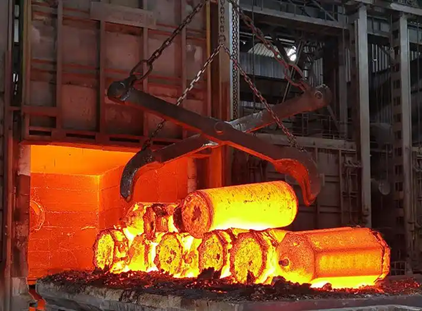Forging is a processing method that uses forging machinery to apply pressure to metal billets, causing them to undergo plastic deformation to obtain forgings with certain mechanical properties, shapes, and sizes. It is one of the two major components of forging.
Forging can eliminate defects such as casting porosity that occur during the smelting process of metals, optimize the microstructure, and at the same time, due to the preservation of intact metal flow lines, the mechanical properties of forgings are generally better than castings of the same material.
Forging has refined grains, dense structure, and coherent forging flow lines, which can improve the mechanical properties of metals.
In addition, forging also has advantages such as high production efficiency and material savings. Therefore, forging plays an important role in metal hot working.
Open forging
Open forging mainly refers to the processing method of forging parts, which uses simple universal tools or directly applies external force to the billet between the upper and lower glued iron blocks of the forging equipment to deform the billet, thereby obtaining the required shape and internal quality.
Open forging products have a simple shape and can be directly forged into shape on forging machines. Open forging has low precision and simple shape, but high flexibility, low cost, and short production cycle. Its shape and size are generally guaranteed by operators using universal tools, mainly used for single piece and small batch production.
Due to the low production efficiency, high labor intensity, poor forging accuracy, and large machining allowance of free forging, the proportion of open forging in the total forging volume is decreasing with the advancement of production technology.
Advantages of open forging
l The forging has great flexibility, ranging from forging small parts weighing less than 100 kilograms to forging heavy parts weighing over 300 tons; Can process long axis, annular, and special-shaped forgings;
l Most of the tools used are universal tools, which are relatively simple and highly versatile;
l Low precision requirements for equipment;
l Short production cycle;
l If the same forging is to be forged, the tonnage of forging equipment required for free forging is much smaller than that for model forging, and the forging forming of free forging is to gradually deform the billet in different regions;
Die forging
Die forging refers to the forging method of obtaining forgings by using molds to shape blanks on specialized forging equipment. The shape of forged products is relatively complex, and they are formed by extruding from the upper and lower mold cavities. The forgings produced by this method have precise dimensions, small machining allowances, and complex structures.
Advantages of die forging
l High production efficiency, metal deformation occurs in the mold cavity during forging, so the desired shape can be obtained quickly;
l Forging can forge complex shaped forgings and make the streamline distribution of the metal more reasonable, thereby improving the service life of the parts;
l Compared to others, the dimensions of forged parts are more precise, with relatively smaller machining allowances and better surface quality;
l Save metal materials, reduce the workload of cutting processing, and also lower the production cost of parts on the premise of sufficient batch size;
Post time: Nov-06-2024





